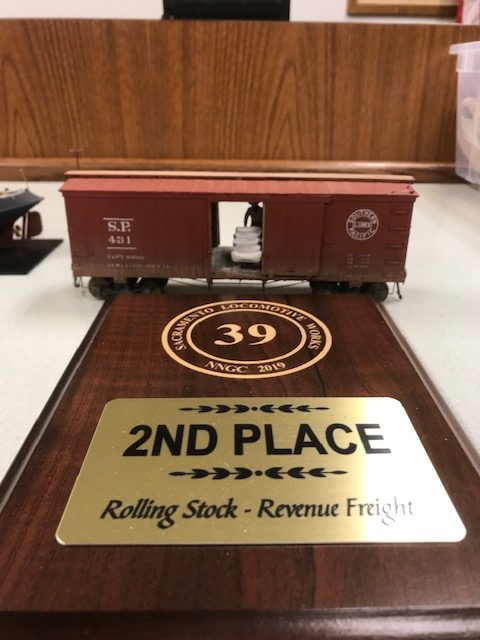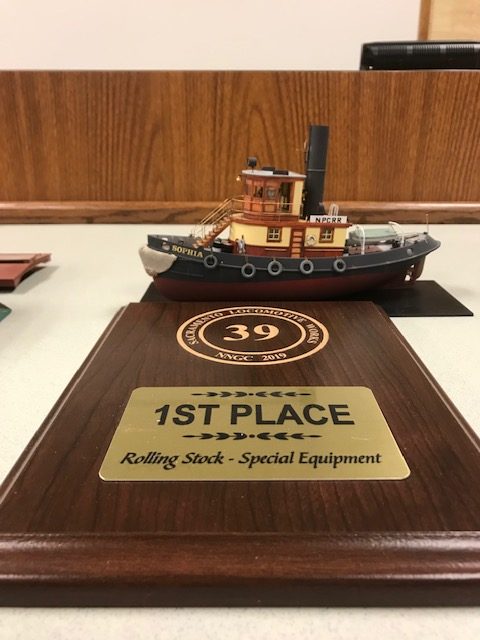Click here to read the October 2019 issue of The Flimsy Board from the Bremerton Northern Model Railroad club.
Grab Iron Posts
Mount Vernon Clinic Important Announcements
By Ted Becker
The Mount Vernon Clinic is changing its meeting night to the third Monday of the month beginning in October 2019 and will continue on the third Monday after that. The next meeting will be October 21. The clinic is still located at the Mount Vernon Senior Center and the meeting starts at 7:00. This change moves us away from being back-to-back with our sister clinic in Oak Harbor and opens participation to folks with Thursday conflicts.
Also our meeting room will be in the craft room where we were last season.
The previously announced change to the larger meeting room did not work out.
To kick off our meeting on the new date will be a clinic on decals by Nick
Muff and Al Carter which is shaping up to be a very informative presentation.
Ted Becker
Westside Clinic This Tuesday October 8th
By Bill Hupé
This coming Tuesday, October 8th, is our Westside Clinic in Bremerton.
Steve Hauff is presenting our clinic and the subject is “Lies, Loggers and Logging Railroads.”
Bob Jensen will talk about “What’s Happening” in the upcoming Bremerton Northern Model Railroad Club move into Kitsap Mall.
Jack Hamilton will be there and hopefully he will bring some new tools he discovered and talk about what’s going on in the PNR and NMRA.
If someone from the 4th Division Board of Directors is there, I’m sure they will be happy to talk about what’s happening at the Division level.
The clinic is held at the United Way of Kitsap Building in downtown Bremerton (647 4th Street) at 7:00 PM.
As usual there will be a “Show and Tell”. If you have a friend or family member who is interested in model railroading, they are welcome.
See you there.
For more information contact me (Bill Hupé) at whopay@tscnet.com or 360-621-5041.
Bill Hupé
October North End Clinic is Thursday October 3rd
By Lisa Murray
The north end NMRA clinic’s program for October is a Beginners Operating Session hosted by Burr Stewart.
If you are interested in seeing what an operating session entails, or even if you have model railroad operating experience, this clinic will be a practicum in operations and a chance to operate trains on Burr’s expansive home layout, The Burrlington Northern Railroad.
The clinic will be held on Thursday, October 3, from 7:00pm to 9:00pm at Burr’s home which is located at 204 NW 112th St., Seattle 98177. There is plenty of parking at or near the house, and it is located in between the #5 and #28X bus lines north of Greenwood.
The railroad has seven working yards from Tukwila to Bellingham, and there are Thru, Local, and Switching jobs from which you can choose. You will also have the option to work in single or two-person crews. The operation is set in 1973 and uses car cards and waybills for car routing and track warrants for train authority, with an NCE DCC throttle system. WiThrottle will also be available if you prefer to use your cellphone for train control. There are also a few new ProtoThrottles available if you want to try them out.
Since we will only have two hours for the ops session, the goal is not to finish all the jobs, but to give folks who have been interested in operating sessions a taste of what’s involved (and the fun that it is!).
That being said, if you have ops experience, please come! We’d love to have as many people there to provide input and share their experiences.
Attached you will find documentation about the railroad layout to help you prepare for next Thursday.
The four files attached include:
- a diagram (track plan) of the layout
- a detailed SPINS document which outlines the numbering and coding system used on the Burrlington RR
- general instructions for operators
- specific train instructions for all the jobs on the railroad, so you can identify the type of jobs you would like to do at the ops session
Please RSVP if you are planning to attend so we can get a sense of how many people will be there.
RSVP to this email (mattinata@outlook.com)with the following information:
Name
Number attending
Operating session level of experience
I am looking forward to seeing you at Burr’s!
Lisa
The Hi-Railers Will be at Lynden This Weekend
By Ed Ives
Yes, it’s a little late confirming our attendance at the Lynden Lions Train Show this weekend October 5th and 6th. To be honest last week I thought we might have to cancel as the guys were dropping like flies in DDT*. We are however in recovery and are eager to go. The plan is for a 31′ x 43′ double track layout comprising a total of 33 modules complete with our eleven track yard. The show runs from 9 am until 5 pm on Saturday and 10 am until 4 pm on Sunday. Come and play trains!
* Do you remember those days prior to DDT being widely available? Flyswatters and rolled news paper were used to attack these pesky insects. Alternatively you could use fly paper hanging from lampshades that had a sticky surface and a fly attractant. These things after a few days would collect a good number of those bugs but usually over the dinner table as that’s where the lamp was. Not nice! Then in the early 1950’s DDT became available in a spray form. A couple of pumps in the air with this spray and any bug passing through the mist would meet with instant death. Ah vengeance! We knew not what we were doing.
Ed
N Gauge Train Layout Available
By Ed Ives
For you N gauge guys we have available a nice layout roughly 4′ x 7′ looking for a new home. It does contain the basic scenery and is in need of a little TLC along with accessories as well as trains. It was found whilst going through the estate of one of our members and has been in storage for some years. Like an abandoned pet, we need to find a good home for this layout, or failing that it will be destroyed. The advantage with this is, no adoption fee required, no shots required, no license required, no need to take it for walks and we’ll consider free delivery in the greater Seattle area. This layout must go one way or another before the end of October.

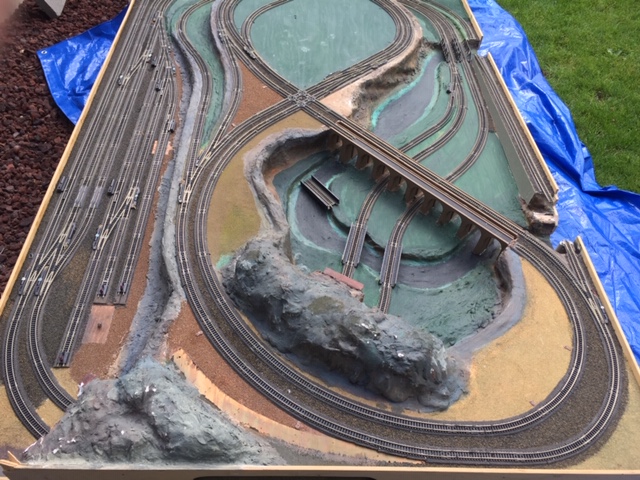
Ed Ives
gresley7@gmail.com
Olympia Clinic and the 39th National Narrow Gauge Convention
By Gregory Wright
Four members of the Olympia monthly clinic group travelled to Sacramento to the 39th National Narrow Gauge Convention in September. Two members brought models for the contest room and five of the six models won awards. Greg Wright won a second place in internal combustion. Harry Avis won a third place in maintenance of way, a second place in rolling stock and two first places, one in cabooses and one in special equipment.
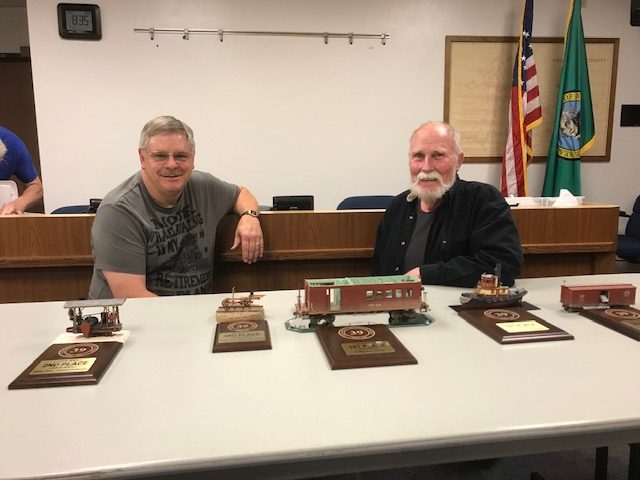

The Olympia Clinic meets on the third Friday of each month. Contact Greg Wright, gregorywright2002@yahoo.com for details. The group plans a review of the national narrow gauge convention at their February 21, 2020 meeting. Other topics in 2019-2020 include scratchbuilding, weathering and prototype photos tours.
Gregory
Workshop Volunteers Needed
By Kurt Laidlaw
There will be an open workshop for the 4D HO model railroad display at the Tacoma Lutheran Retirement Center, 1301 N Highlands Pkwy, Tacoma WA on Saturday, October 12 between noon and 4 PM. Anyone is welcome to come help improve the layout and get it ready for the next “train day” the following Tuesday. We are looking for people who can saw, ballast, add scenery, clean track, solve electrical mysteries, change out wheel sets and couplers and any other modeling skills you can think of. If you have extra scenery making stuff, it would be put to good use. We have some ground foam, plaster cloth, Arizona Rock & Mineral ballast, glue and paint.
If you have time and skills you are willing to donate to this very worthwhile project or you just want to drop by and see what we are doing, please contact Warren Kerr (warrenkerr@rocketmail.com) or Kurt Laidlaw (ananas99@klaidlaw.net) so they can get your name to the receptionist at the front door.

Kurt Laidlaw
President, Pacific Northwest Region, NMRA
Skagit Valley and Whidbey Clinic September 2019 Meeting – An Evening about Scratchbuilding
Article and Photos by Rich Thom
Clinic Chair Rich Blake welcomed 26 to the first SV&W NMRA Clinic of the season. This clinic was devoted to scratchbuilding; so without further ado, let’s get to it.

Area modelers were invited to bring in their scratchbuilding efforts, both completed and in progress, and most are on the table next to Cliff Aaker (Fig 1), who led off the evening with his presentation “Methods and Tools for Scratchbuilding Scale Models.” Cliff discussed his general approach, in which he either copies a commercial model—to improve upon it by adding details and “personality” for his own railroad—or more typically working from prototype photos. From photos he works out roof pitch and other dimensions using window, door and other features–for example, a standard door height of 6’10”. Often he builds a paper or art board mockup for a project if it’s complicated or must fit a precise space; his first such was building a road bridge for the Anacortes & Fidalgo Model Railroad Club, whose members are long-time clinic contributors.
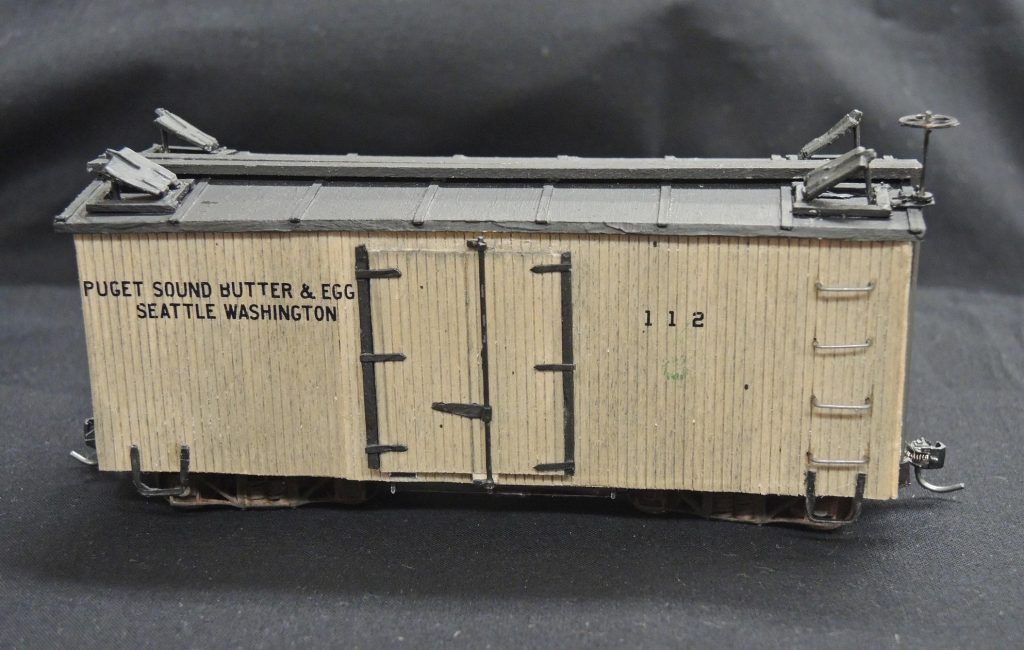
Like most everyone, Cliff uses a mix of purchased and scratch detail parts. For his On30 reefer in Fig 2, brake wheels, roof hatches, turnbuckles—and of course couplers–are commercial parts. Other details, door hardware, latches, stirrups, and grab irons are scratch. Cliff passed around his grab iron bending and drilling jigs; the stirrups are fashioned from bent staples.
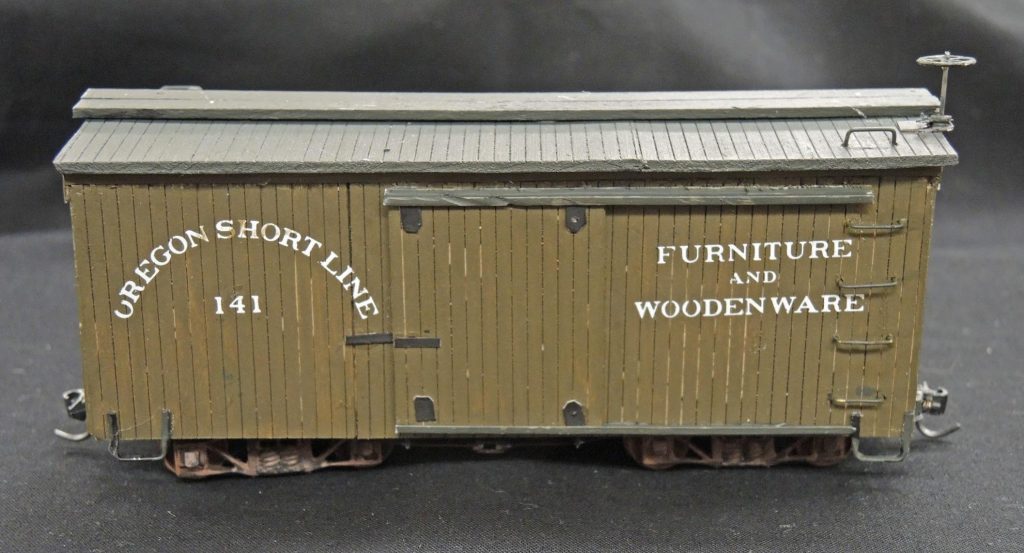
Cliff’s box cars (Fig 3 shows one example) are built over a solid wood core, or plug. This automatically keeps all car sides and ends square and provides the needed weight. All car sheathing is Kappler Lumber scribed wood. Roofs are either wood planks or ribbed metal. Metal ribs are simulated with paper strips cut with a rotary cutter. The styrene door channels were glued to the carbody with “old” thick styrene glue, which Cliff found to adhere well to wood.

Flatcars (Fig 4) are difficult to weight properly without unsightly lead weights glued to the underbody, or weighted loads. Cliff solves this by using 1/16” lead sheet sandwiched under the decking. The stake pockets are commercial parts, the stirrups scratch.
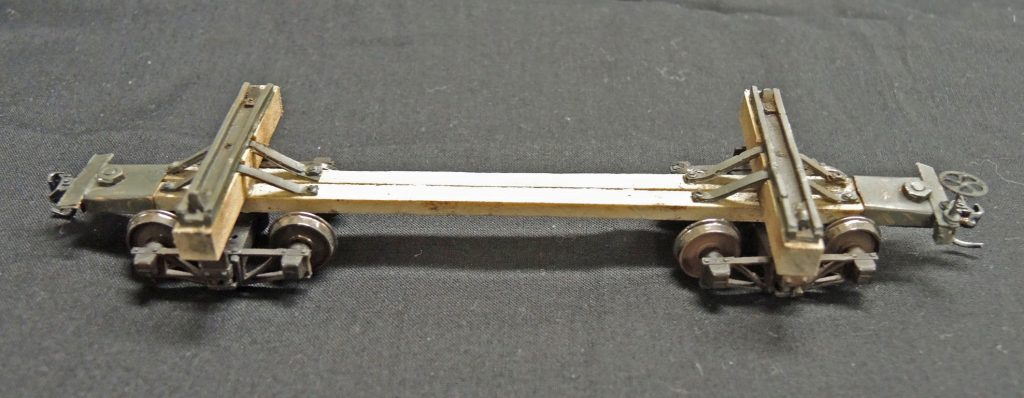
The metal parts on the skeleton log car in Fig 5 were fabricated using concrete patch and latex rubber molds. (Cliff described multiple uses of two types of concrete patch at our March 2019 clinic.) The trucks on this car, available from Precision Vintage Classics (www.pvc-sn3.com), use 3D-printed sideframes. The cars in Figures 2 and 3 also use PVC trucks.
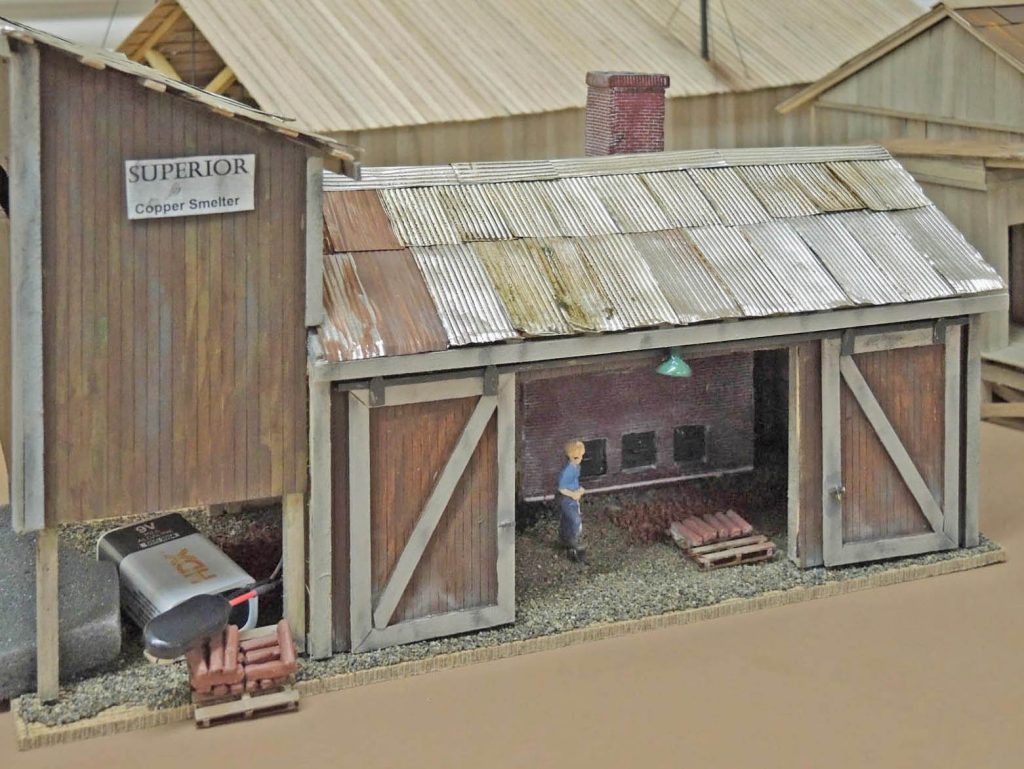
Cliff brought two of his scratchbuilt O-scale buildings to discuss some of the construction methods used. The copper smelter (partial view in Fig 6) was based on drawings of a smelter in Bodie, CA published in Narrow Gauge & Short Line Gazette. Quickcrete Concrete Crack Seal was used to make the furnace and chimney. The roofing is ordinary household aluminum foil cut with a rotary cutter and scissors, then shaped with a tool from Brunel Hobbies, their “Corrugated Iron Maker” (www.brunelhobbies.com.au). Cliff uses all three readily available thicknesses of aluminum foil in his models.

The freelanced depot (Fig 7) was designed with a deliberately high-peaked roof, 12/12 pitch, to provide maximum elevation for an IR sensor which, in conjunction with a servo, battery and Arduino, operates a train order signal (not shown) using a TV remote. During assembly, walls were kept square using a fixture constructed of Lego pieces. The beautifully-executed roof is built with individual Western Red Cedar roofing shakes. Thin wood sheets of cedar were cut into strips with a rotary cutter, chopped, and applied one-by-one with double-sided tape. Fine work, Cliff, and a great clinic!
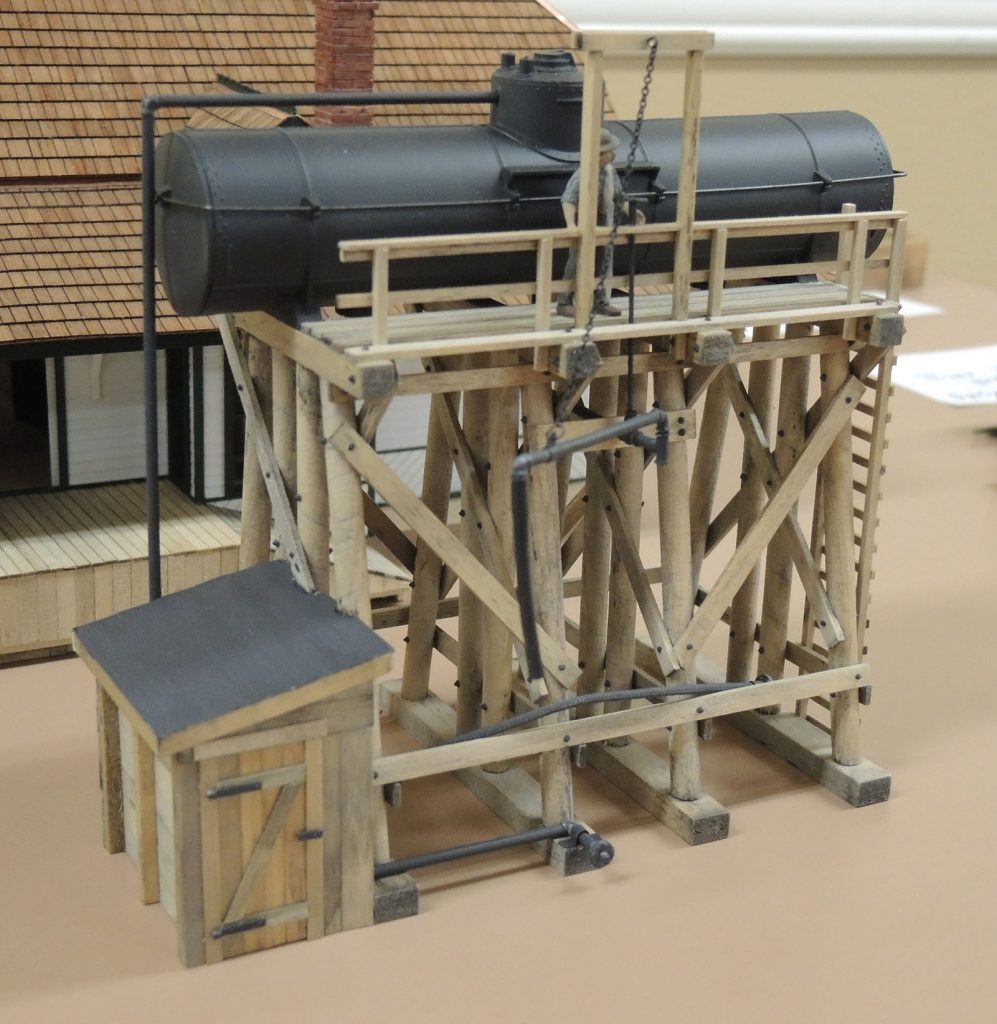
Other scratchbuilders in the group had the opportunity to describe their show-and-tell items. Alan Murray brought two of his fine O-scale structures, including the oil tank in Fig 8. Alan has discussed his techniques in several of our previous clinics, which include sawing all of his scale boards from sheet—no purchased (expensive) stripwood for him! Note the N-B-W castings, essential for any model to qualify for an NMRA Achievement Program award.
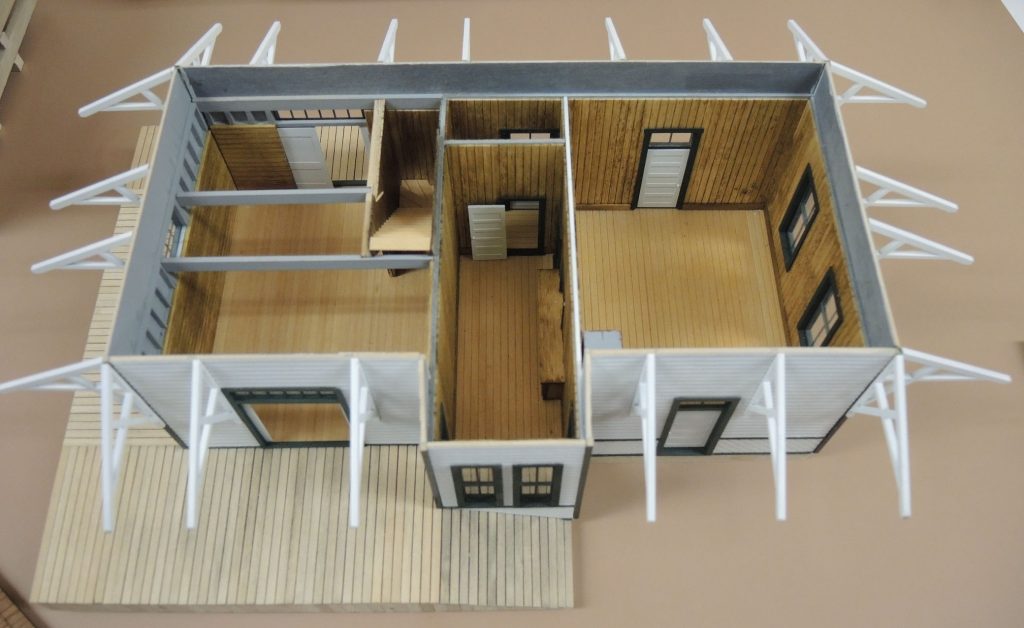
Alan showed slides detailing the history of the train station in Olympia, and his remarkable reproduction of it in O-Scale. The single photo of it here (Fig 9) can’t possibly do it justice. It sits not on land, but a pier, and the pier (not shown) is just as well-crafted as the station. Alan has featured his Olympia station module construction in previous clinics.
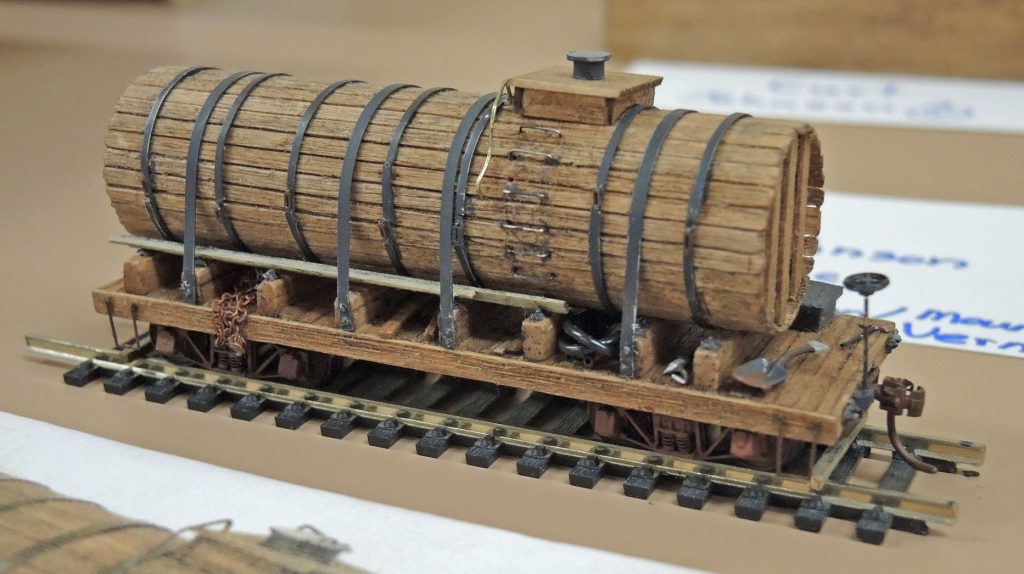
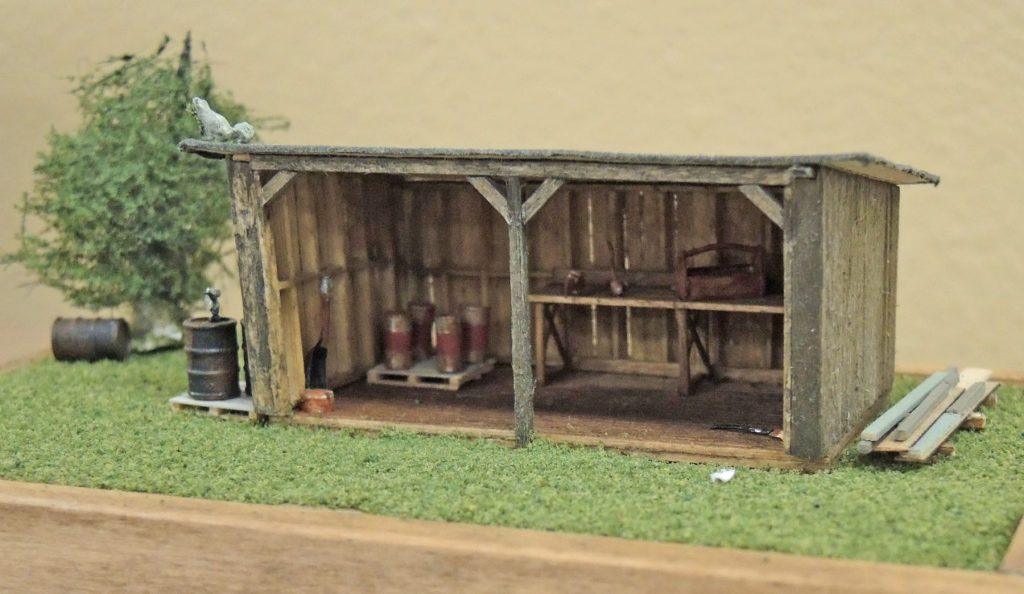

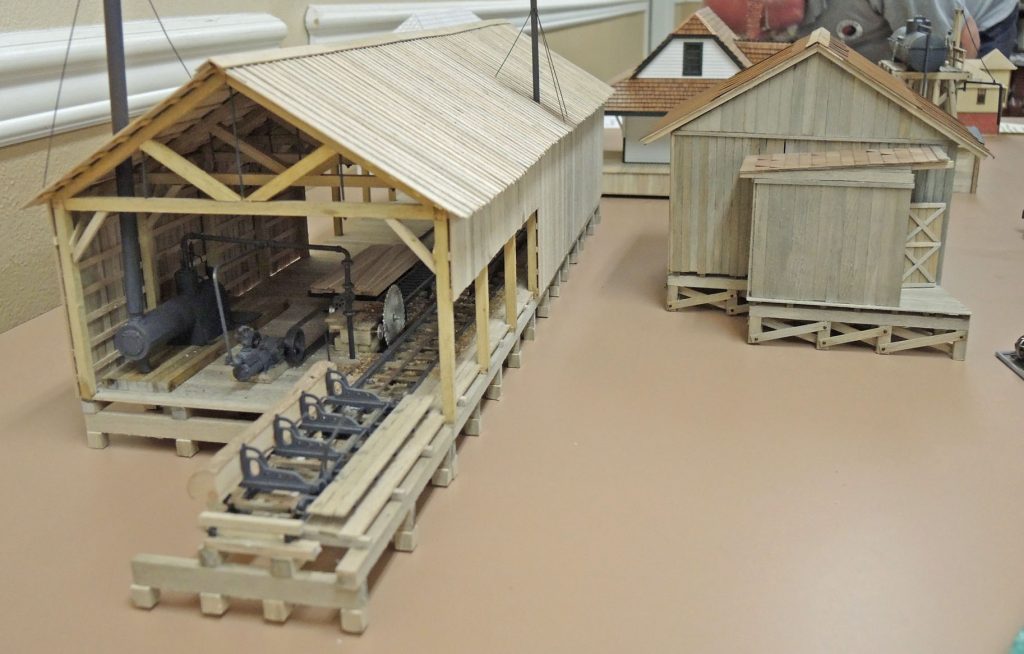
Iver Johnson showed off his water tank for a logging line, Fig 10. Curt Johnson got the idea for his scratch shed, Fig 11, from a Walther’s Catalog. Jack Tingstad built the replica of the Tennessee Pass Station, Fig 12, from plans he was able to obtain after he was unsuccessful in finding one of the original kits which had gone out of production. Jon Bentz brought two of his O-scale structures, both freelance, a sawmill and a work-in-progress freight house (Fig 13).
Thanks to all for bringing in some fine models and describing some of their techniques.
###
Clinic Report – East Side Get Together – September 2019
By Syd Schofield
The National Model Rail Road Association Fourth Division of the Pacific Northwest Region (NMRA 4dPNR) Redmond Clinic for September was held Thursday evening at the Redmond Community Center, Alex Brikoff presiding. After a brief social interlude, the gathering was brought to focus around 7:15 PM. Notable attendees were introduced and upcoming events of interest were announced. The 4D Grab-Iron newsletter and Events Calendar are a great resource to keep you abreast of activities.
As we reminisced our train-themed vacation trip activities over the summer, several of the group gave short presentations about new layouts being designed, planned and built. Due to the great interest we ran over the allotted meeting time. It’ll be very interesting to hear the progress reports on these new layouts as time goes on.

For the model of the month and photo if the month, Russ Segner showed two brass locomotive purchases, an Sn3 consolidation and an HOn3 consolidation. Bob Rorabaugh showed an article on massive northwest tree stumps and the stories they hold. Syd Schofield showed a picture of the Bear River bridge and trestle on the Nevada County Narrow Gauge Railroad in northern California obtained at their museum in Grass Valley, CA.
Bob Rorabaugh brought his usual “For Sale” items as an opportunity available to all attendees. Due to the clinic running late, the door prize portion of the clinic was very abbreviated with a promise to return to the regular door prize give away next month. The meeting concluded at 9:15 PM.
Syd

